By Nova, BAMS – Ayurvedic Practitioner
I’ll never forget the day a patient walked into my clinic wearing a beautiful polyester blouse, scratching her arms until they were red and raw. She’d spent thousands on dermatologists, allergy tests, and prescription creams. Nothing worked.
I asked her one simple question: “What are you wearing?”
She looked at me like I was crazy. But three weeks after switching to natural fabrics, her chronic rashes were gone. Completely.
Here’s what nobody tells you: The fabric touching your skin 24/7 matters just as much as the skincare products you spend hundreds on. Maybe more.
As an Ayurvedic practitioner (BAMS) specializing in skin health, I’ve seen this pattern repeat hundreds of times. Your mysterious skin problems might not be a skin problem at all—it’s a fabric problem.
Let me share the best fabrics for sensitive skin that I recommend to every single patient who walks through my door.
Why Choices Of Fabric Matter More Than We Think
Before we dive into the best fabrics, you need to understand something critical:
Skin is the largest organ. It breathes, absorbs, and reacts to everything that touches it. When you wear synthetic fabrics like polyester, It’s like wrapping your body in plastic for 12+ hours a day.
Think about that for a second.
In Ayurveda, we’ve known for thousands of years that what touches your skin is just as important as what you put on it. Modern science is finally catching up.
A study (2023) published in the Journal of Dermatological Science found that synthetic fabrics can:
Trap heat and moisture against your skin
Disrupt your skin’s natural pH balance
Trigger allergic contact dermatitis
Worsening conditions like eczema, psoriasis, and acne
Now, let’s talk solutions.
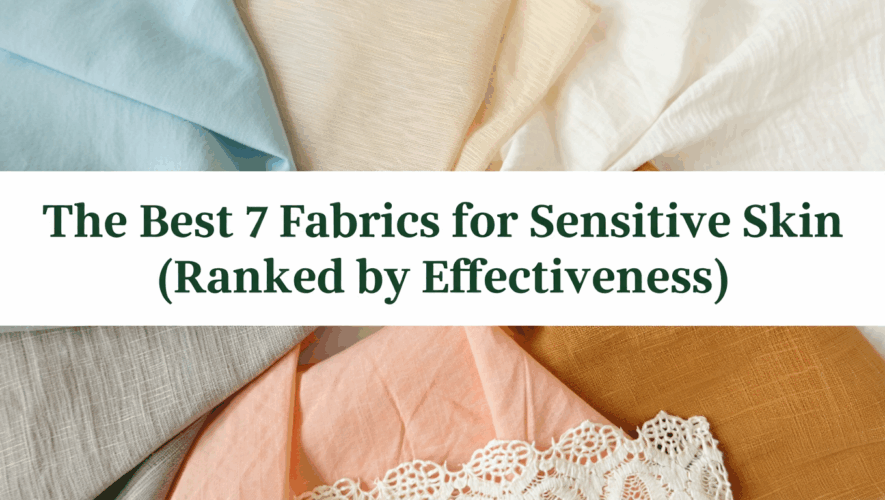
The Best 7 Fabrics for Sensitive Skin (Ranked by Effectiveness)
1. Organic Cotton: The Gold Standard for Sensitive Skin
Why is it no.1: Organic cotton is breathable, soft, and hypoallergenic. Unlike conventional cotton (which is treated with pesticides and harsh chemicals), organic cotton is grown without toxic substances.
Best for: Everyday wear, underwear, bedding, baby clothes
Ayurvedic perspective: Cotton is considered sattvic (pure) in Ayurveda, meaning it doesn’t disturb your body’s natural balance.
What to look for: GOTS-certified organic cotton
Real talk: I switched my entire wardrobe to organic cotton five years ago, and my patients always comment on how my skin “glows.” It’s not magic—it’s just letting my skin breathe.
2. Linen: The Ancient Fabric That Heals
Why it works: Linen is naturally antibacterial, moisture-wicking, and gets softer with every wash. It’s also one of the strongest natural fibers, so it lasts forever.
Best for: Summer clothing, lightweight dresses, sheets
Ayurvedic perspective: Linen has cooling properties, making it perfect for Pitta types (people with sensitive, inflammatory skin conditions).
What to look for: 100% European flax linen
Patient story: One of my patients with chronic heat rash switched to linen work clothes. Her rash disappeared within two weeks. She told me, “I didn’t realize I’d been uncomfortable for YEARS.”
3. Bamboo Fabric: The Sustainable Skin Saver
Why it works: Bamboo fabric is incredibly soft (like cashmere), naturally antimicrobial, and moisture-wicking. It’s also eco-friendly.
Best for: Activewear, underwear, socks, pajamas
The catch: Make sure it’s mechanically processed bamboo (bamboo linen), NOT chemically processed viscose/rayon bamboo.
What to look for: Labels that say “bamboo linen” or “mechanically processed bamboo”
Pro tip: Bamboo is my go-to recommendation for people with fungal skin issues or excessive sweating.
4. Silk: Nature’s Luxury Healer
Why it works: Real silk contains natural proteins and amino acids that are gentle on skin. It’s hypoallergenic, temperature-regulating, and reduces friction (which means fewer wrinkles!).
Best for: Pillowcases, sleepwear, delicate garments, scarves
Ayurvedic perspective: Silk is cooling and calming, perfect for sensitive skin types.
What to look for: 100% mulberry silk (19-22 momme weight)
Real talk: Silk pillowcases changed my life. No more morning creases on my face, and my skin stays hydrated overnight.
5. Hemp: The Underrated Champion
Why it works: Hemp is durable, breathable, naturally antimicrobial, and actually protects your skin from UV rays.
Best for: Everyday clothing, jeans, bags, outdoor wear
The perception problem: Hemp has gotten a bad rap for being “scratchy,” but modern hemp fabrics are soft and comfortable.
What to look for: Hemp blends (hemp + organic cotton) for softness
Fun fact: Hemp gets softer with every wash. Give it time.
6. Merino Wool: Not Your Grandma’s Itchy Sweater
Why it works: Modern merino wool is soft, breathable, moisture-wicking, and naturally odor-resistant. Unlike regular wool, it doesn’t itch.
Best for: Winter wear, activewear, base layers, socks
The surprise: Even people with “wool allergies” can often wear merino wool—it’s the coarse regular wool that causes problems.
What to look for: Superfine merino wool (18.5 microns or less)
Patient testimonial: “I thought I was allergic to wool my whole life. Turns out, I just needed better quality wool!”
7. Tencel (Lyocell): The Eco-Friendly Tech Fabric
Why it works: Tencel is made from sustainably sourced wood pulp using a closed-loop process. It’s soft, breathable, moisture-wicking, and biodegradable.
Best for: Activewear, summer dresses, sheets
The science: Tencel fibers have a smooth surface, so bacteria can’t cling to it—perfect for acne-prone skin.
What to look for: TENCEL™ branded fabric (made by Lenzing)
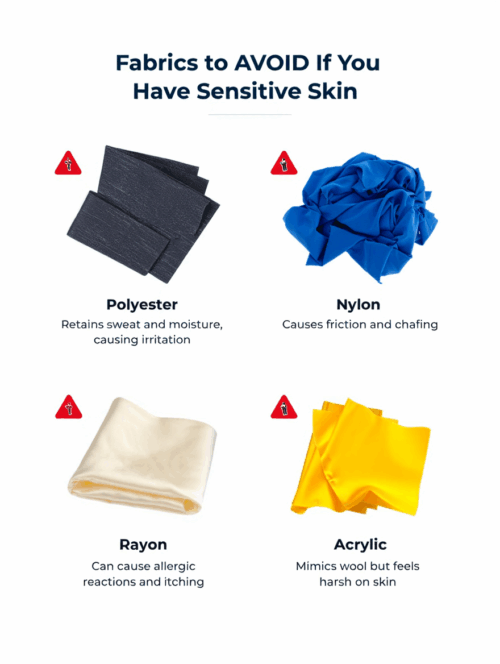
 Fabrics to AVOID If You Have Sensitive Skin
Fabrics to AVOID If You Have Sensitive Skin
1. Polyester (The #1 Skin Enemy)
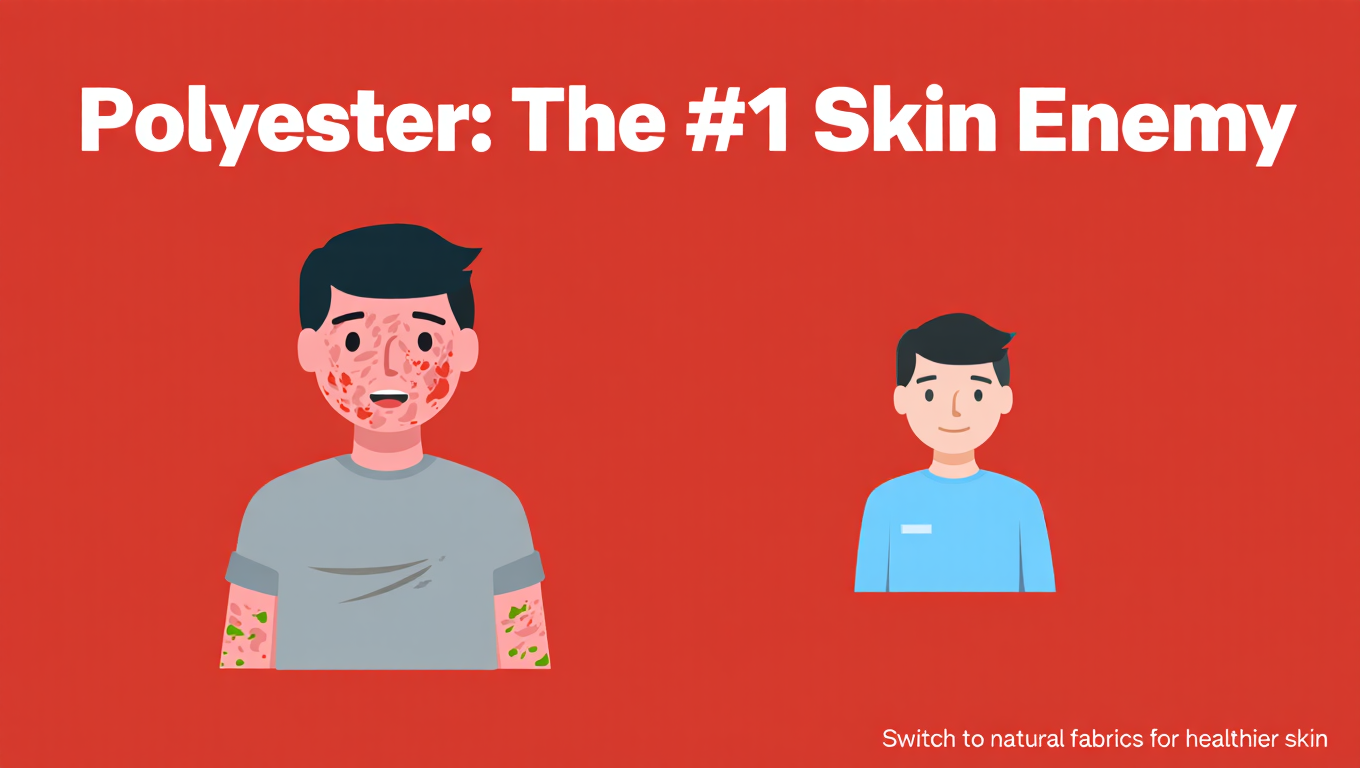
Why it’s terrible: Polyester is literally plastic. It traps heat, blocks airflow, and can leach chemicals into your skin.
The hidden danger: Most “fast fashion” is 100% polyester. That $15 dress might be destroying your skin.
My rule: If it’s shiny, stretchy, and cheap, it’s probably polyester. Avoid it.
2. Nylon
The problem: Like polyester, nylon is synthetic and non-breathable. It’s also prone to causing friction irritation.
Where it hides: Activewear, tights, underwear, bras
Better alternative: Bamboo or merino wool activewear
3. Rayon/Viscose
Why it’s problematic: Made with harsh chemicals (including carbon disulfide, which is toxic). It also pills easily and loses shape.
The confusion: People think rayon is “natural” because it’s made from wood pulp, but the chemical processing makes it synthetic.
Better alternative: Tencel (which uses a non-toxic process)
4. Acrylic
The issue: Acrylic is basically plastic wool. It doesn’t breathe, causes static, and can irritate sensitive skin.
Where it hides: “Wool-like” sweaters, winter scarves, blankets
Better alternative: Real merino wool or cotton blends
 Key Takeaways: Quick Reference Guide
Key Takeaways: Quick Reference Guide
 Best Natural Fabrics for Sensitive Skin:
Best Natural Fabrics for Sensitive Skin:
Organic cotton – everyday essential
Linen – cooling & antibacterial
Bamboo – soft & antimicrobial
Silk – luxurious & healing
Hemp – durable & protective
Merino wool – winter comfort
Tencel – eco-friendly tech
 Fabrics to Avoid:
Fabrics to Avoid:
Polyester (plastic = skin enemy #1)
Nylon (non-breathable)
Rayon/Viscose (toxic chemicals)
Acrylic (synthetic irritant)

FAQ: Your Fabric Sensitivity Questions Answered
Q: Can I wear cotton if I have sensitive skin?
A: Yes! But make sure it’s organic cotton. Conventional cotton is one of the most pesticide-heavy crops in the world. Those chemicals stay in the fabric and can irritate your skin. Always look for GOTS-certified organic cotton.
Q: Why does my skin react to “natural” fabrics like cotton?
A: Two reasons:
It’s not truly natural – Most “cotton” clothing is blended with polyester or treated with formaldehyde (yes, really) to prevent wrinkles.
You might have a dye allergy – Synthetic dyes can cause reactions. Try undyed or naturally dyed fabrics.
If you’re reacting to supposedly “natural” fabrics, take my free 5-minute Fabric Sensitivity Assessment to identify your specific triggers.
Q: Is bamboo fabric really better than cotton?
A: It depends on the processing:
Mechanically processed bamboo (bamboo linen) = EXCELLENT for sensitive skin
Chemically processed bamboo (viscose/rayon) = NOT good (same issues as regular rayon)
Always check the label. If it just says “bamboo,” it’s probably the chemical version. Look for “bamboo linen” specifically.
Q: I can’t afford to replace my entire wardrobe. Where should I start?
A: Smart question! Prioritize these in order:
Underwear & bras (touching your most sensitive areas 24/7)
Bedding (you’re in bed 8 hours/night)
Base layers (t-shirts, camisoles—directly on skin)
Workout clothes (sweat + synthetic fabric = skin disaster)
Everyday tops
You don’t need to do it all at once. Even swapping your underwear to organic cotton can make a HUGE difference.
Q: What about “moisture-wicking” fabrics for workouts?
A: Here’s the truth: Polyester workout clothes are marketed as “moisture-wicking,” but they actually trap bacteria and odor. That’s why your gym clothes smell awful even after washing.
Better options:
Merino wool activewear (naturally moisture-wicking + odor-resistant)
Bamboo athletic wear
Organic cotton (for low-intensity workouts)
Yes, they’re more expensive. But your skin (and your nose) will thank you.
Q: Can fabric sensitivity cause acne?
A: ABSOLUTELY. I see this all the time with:
Face masks (synthetic masks = maskne)
Polyester pillowcases (trapping oil, bacteria, and skincare products against your face all night)
Workout clothes (sweaty synthetic fabric on your back/chest = body acne)
Read my full article on how fabrics trigger acne on TwakaSutra—it’ll blow your mind.
Q: How do I know if my rashes are from fabrics or something else?
A: Great question! Here are the telltale signs of fabric sensitivity:
It’s probably fabric sensitivity if:
Rashes appear where clothing is tight (waistband, bra line, socks)
Symptoms worsen after wearing new clothes
Itching intensifies when you’re hot/sweating
Skin improves on weekends (when you wear comfy clothes)
Rashes improve when you’re naked (sorry, had to say it!)
It’s probably NOT fabric if:
Rashes appear on areas not covered by clothing
No pattern related to clothing
Food triggers are obvious
Want to know for sure? Take my FREE Fabric Sensitivity Assessment—it’s a 5-minute quiz that identifies your specific triggers. Over 2,000 people have used it to finally figure out what’s causing their mystery rashes.
My Personal Fabric Journey (Why I’m Passionate About This)
Five years ago, I was treating patient after patient for “unexplained” skin conditions. Eczema. Contact dermatitis. Chronic rashes. Acne that wouldn’t budge.
I’d prescribe creams, recommend diet changes, and suggest stress management. Some patients improved. Many didn’t.
Then one day, I noticed something: The patients who got better had one thing in common. They’d mentioned changing their clothes, switching their sheets, or ditching their workout gear.
That’s when it clicked.
I dove deep into research—ancient Ayurvedic texts AND modern dermatological studies. The evidence was overwhelming: Fabric matters.
I started asking every patient: “What are you wearing?”
The results were shocking. About 60% of my “mystery skin condition” patients improved dramatically just by switching fabrics. No medication. No expensive treatments. Just better clothes.
That’s why I started TwakaSutra—to share this knowledge with people suffering unnecessarily.
If you’re dealing with chronic skin issues that won’t go away, I genuinely believe fabric sensitivity could be your missing puzzle piece.
 Ready to Transform Your Skin?
Ready to Transform Your Skin?
Here’s what to do next:
Step 1: Take the Free Fabric Sensitivity Assessment
I created a simple 5-minute quiz that tells you:
- Which fabrics to avoid for YOUR skin
Personalized shopping recommendations
Your Ayurvedic skin type (dosha)
https://twakasutra.gumroad.com/l/fabricsensitivitytype
Step 2: Read My Complete Fabric Sensitivity Guide
Want to go deeper? I wrote a comprehensive guide on TwakaSutra covering:
The science behind fabric sensitivity
How to read clothing labels (hidden synthetic ingredients!)
Brand recommendations for every budget
How to transition your wardrobe without going broke
Ayurvedic fabric recommendations by dosha type

https://twakasutra.blogspot.com/
Step 3: Start With One Change
You don’t have to overhaul everything today. Pick ONE item from this list:




Small changes compound. Your skin will notice.
Final Thoughts: Fashion Meets Health
I know this isn’t the typical fashion article you’re used to reading. But here’s the reality:
True style starts with healthy skin.
You can have the most expensive wardrobe in the world, but if your skin is inflamed, rashy, or uncomfortable, you won’t feel confident.
The fashion industry doesn’t talk about this because synthetic fabrics are cheap and profitable. But your health isn’t negotiable.
You deserve clothes that make you look good AND feel good.
As someone who’s seen hundreds of patients transform their skin just by changing their fabrics, I can tell you: This works.
It’s not a miracle cure. It’s not a magic supplement. It’s just giving your body what it needs—breathable, natural materials that work WITH your skin, not against it.
Your skin has been trying to tell you something. Maybe it’s time to listen.

Read more:
https://twakasutra.blogspot.com/2025/10/why-i-stopped-wearing-polyester-and-my.htmlNova, BAMS
Ayurvedic Practitioner & Fabric Sensitivity Specialist
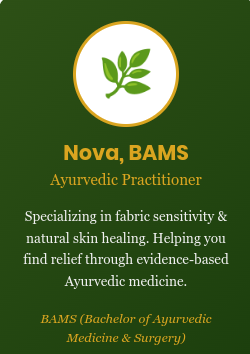
Founder, TwakaSutra
Recommended1 recommendationPublished in Health, Our Fashion Passion, Skin Care
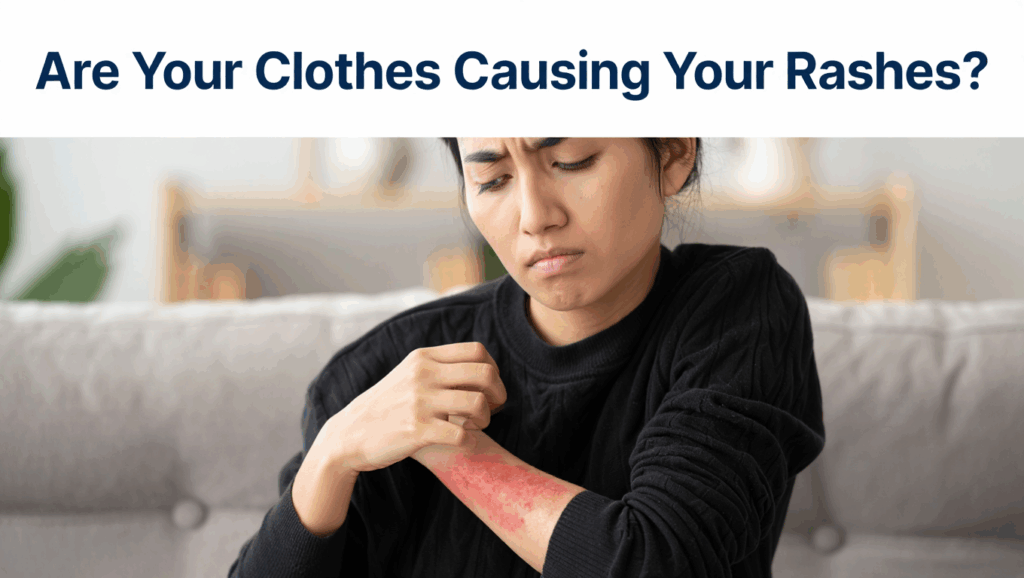
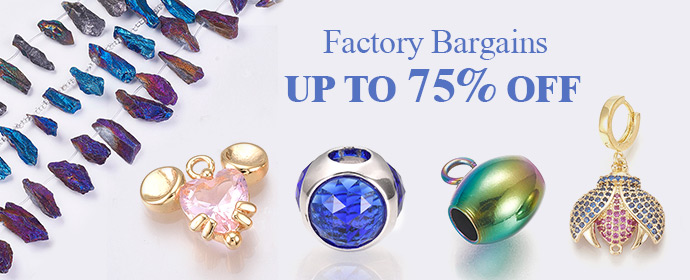





 Fabrics to AVOID If You Have Sensitive Skin
Fabrics to AVOID If You Have Sensitive Skin
 Best Natural Fabrics for Sensitive Skin:
Best Natural Fabrics for Sensitive Skin:
 Fabrics to Avoid:
Fabrics to Avoid:





